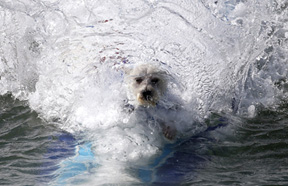
Which of the following wildly popular Hans Christian Andersen adaptations and animated Disney films is acclaimed for featuring a strong and independent female protagonist?
A. The Little Mermaid
B. Frozen
Given the omnipresent discussion surrounding Frozen's charmingly subversive tale of sisterhood—and Ariel's relatively newfound reputation as a bad example for young viewers—the latter seems like the more reasonable answer. But 25 years ago when The Little Mermaid first came out, Roger Ebert praised her as a “fully realized female character who thinks and acts independently, even rebelliously, instead of hanging around passively while the fates decide her destiny.”
Writers have since explicated with gusto the idea that The Little Mermaid is “embarrassingly retrograde in terms of its gender politics," in part because Ariel literally gives up her voice for a chance to be with a man she just spotted on the beach. Still, it’s not difficult to see Ebert’s point. Ariel acted like a typical, love-struck teenager, dissatisfied with her vanilla life under the sea, to the chagrin of Sebastian and his aquatic flash mob. Ebert wasn’t alone in admiring her spunk. While some critics maligned Ariel as a poor successor to earlier “classic” heroes like Bambi or Snow White, others hailed her as “modern Disney heroine,” not to mention “the studio’s first red-haired animated leading lady.”
If looking back at the very first reviews of The Little Mermaid reveals anything, it’s how pop culture’s loose, collective definition of “heroine,” changes over time, sometimes dramatically. What makes a good animated female role model? Should she be opinionated? Bookish? Suspicious of authority? Loyal? Irreverent or even hostile toward traditional gender roles? The nebulous and never-stagnant answer is determined in part by cultural critics and media-makers on one side, and by parents and children themselves on the other.
Before The Little Mermaid, Disney had a short roster of titular female leads who spent a good chunk of the film asleep—Cinderella, Sleeping Beauty, Alice, and Snow White. So what if Ariel spends most of the film without a voice? At least she's awake.
As Willa Paskin noted at Vulture, The Little Mermaid is "a kids' movie ... from a time before studios were even aware that parents would have to watch these things too." It was among the last of a generation of such films, too, though decades away from all-age-pleasing critical successes like The Lego Movie. Perhaps because of the absence of age-appropriate narrative thrills, adult-aged (and male) film critics converged with surprising like-mindedness upon the sentiment that Ariel was above all hot and likable.
In his review, Ebert said audiences have "sympathy for Ariel's scheming," because she's "smart and thinks for herself." The Los Angeles Times’ Michael Wilmington instead remarked on Ariel’s good looks:
“Mermaid's” saucy heroine, Ariel, isn't much like Andersen's sad, noble sea-maid. She's a sexy little honey-bunch with a double-scallop-shell bra and a mane of red hair tossed in tumble-out-of-bed Southern California salon style. She has no gills, but, when she smiles, she shows an acre of Farrah Fawcett teeth.
In 1997, the Boston Phoenix's Jeffrey Gantz noted that "Ariel is sexy as well as sympathetic," and for the film’s 10th anniversary in 1999, Jay Boyar of the Orlando Sentinel noted that "Ariel (Jodi Benson) is sympathetic and, in her little bikini top, rather sexy." Similar (arguably tongue-in-cheek) descriptions of the relentlessly sexualized Disney princesses remained a mainstay in film criticism for years. While animated film's female protagonists today still tend toward the disproportionately buxom or svelte or impossibly beautiful, critics dwell on those physical characteristics far less.
More than a dim-witted, love-drunk nymphet or fierce paragon of girlish ambition, Ariel was a necessary stepping stone to the better-developed, animated female protagonists of the future. Ariel defies her father's authority, but Mulan defies her father's authority in order to save all of China from the Huns. Ariel seeks life beyond the borders of her conventional world, but so does Merida, who doesn't get distracted by a pretty, potential lover's face.
Of course, such progress doesn't happen linearly. Between Ariel and Mulan and Anna and Elsa were Pocahontas, Jasmine, and Belle—each strong-willed and independent in her own right, but more sassy and saucy than liberated. Still, it didn't take 25 years for critics to express their skepticism of Frozen's leading pair. It’s like the Murphy’s Law of Internet-era cultural criticism: Anything that can be deconstructed will be deconstructed. But what matters is that moviemakers are trying to create better female protagonists (and with good reason), and there will always be an audience ready to cherish and meme-ify the flawed yet lovable animated leading women.


















 In Focus
In Focus
Join the Discussion
After you comment, click Post. If you’re not already logged in you will be asked to log in or register.
blog comments powered by Disqus